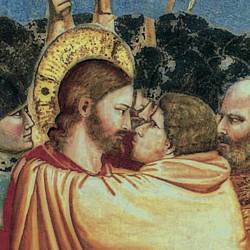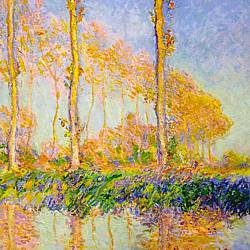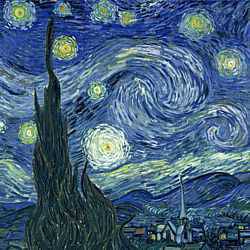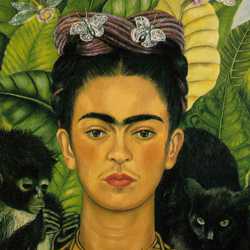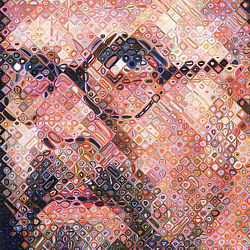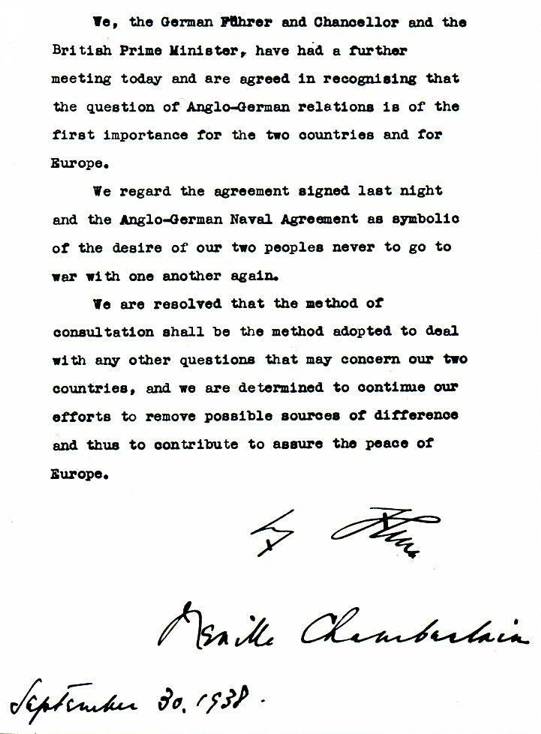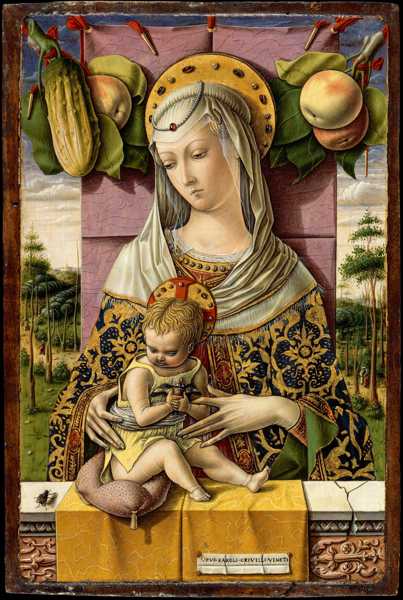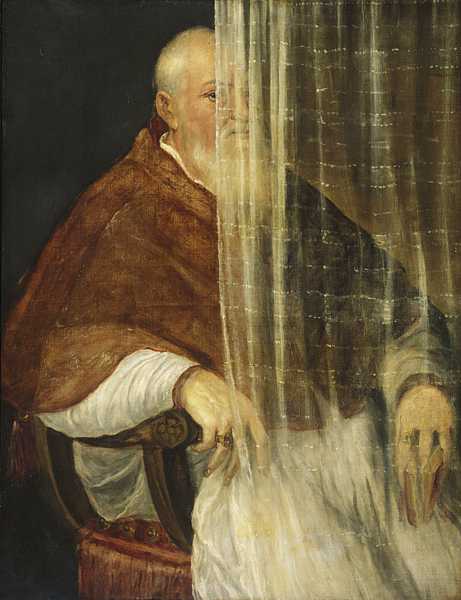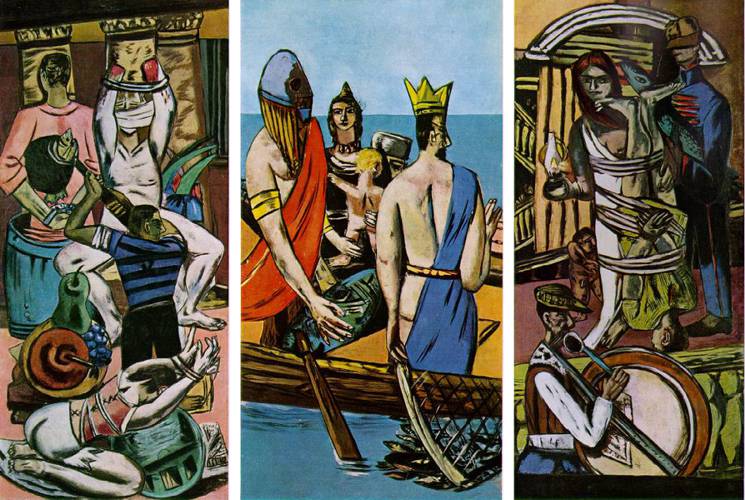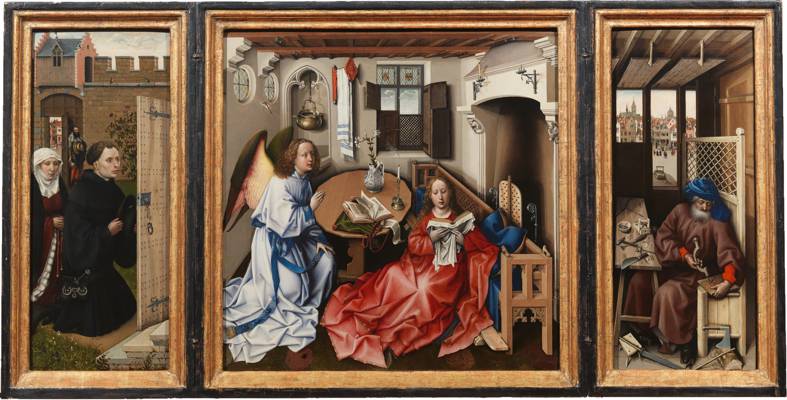Paintings by Francis Bacon
Francis Bacon, the artist, paints provocative and disturbing images that carry a raw sense of anxiety and alienation.

FRANCIS BACON (1909-1992)
'Self Portrait', 1971 (oil on canvas)
Francis Bacon paints disturbing and provocative images that carry a raw sense of anxiety and alienation. They embody that existential fear and loathing that anyone in their right mind experiences when confronted with the atrocities that came to light at the end of World War Two.
Francis Bacon was born in Dublin on 28 October 1909, the second of five children. He referred to his childhood as 'cold and hard', impaired both physically by asthma and psychologically by his violent authoritarian father, a horse trainer and major in the British army. At he age of sixteen, after irreconcilable differences over his homosexuality, his father sent him to live with an uncle in Berlin with the hope of 'reforming his behaviour'. However, counter to his father's expectations, the Berlin that his uncle introduced him to was the uninhibited nightlife of the 'Golden Twenties' – a cultural melting pot for radical social, political, and artistic ideas.
'Crucifixion' 1933
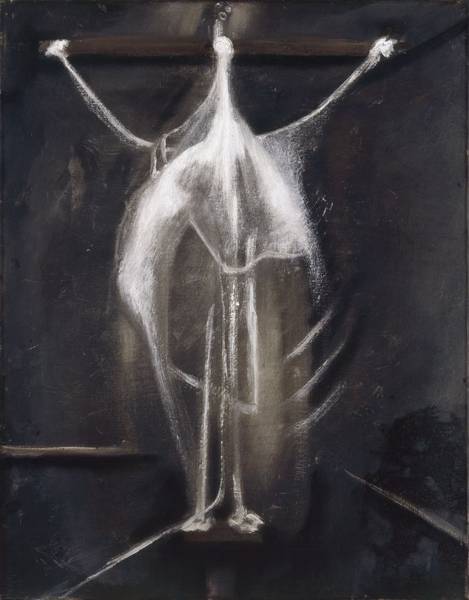
FRANCIS BACON (1909-1992)
'Crucifixion', 1933 (oil on canvas)
Following his exposure to the excesses of 1920's Berlin, Bacon moved to Paris in 1927 where he immersed himself in its bohemian culture. It was here that he decided to become an artist after seeing an exhibition of Picasso at the Galerie Paul Rosenberg. Picasso's vision, which had challenged the traditional forms of representation that had endured since the Renaissance, both inspired and empowered Bacon who had no academic training in art. It offered him the freedom and confidence to draw and paint unencumbered by the conventions of the art establishment.
The following year he returned to London and set up an interior design studio in South Kensington which paid the bills while he continued his search for an artistic voice. His paintings of this period were influenced by Surrealist abstraction but did not gain much critical success. One piece that did stand out was a 'Crucifixion' painted in 1933. Although it owes much to Picasso's biomorphic forms from the late twenties and early thirties, it suggests the shape of things to come: an exposed and tortured figure locked within a rigid framework and painted with an instinctive sensitivity for expressive brushwork.
'Three Studies for Figures at the Base of a Crucifixion' 1944
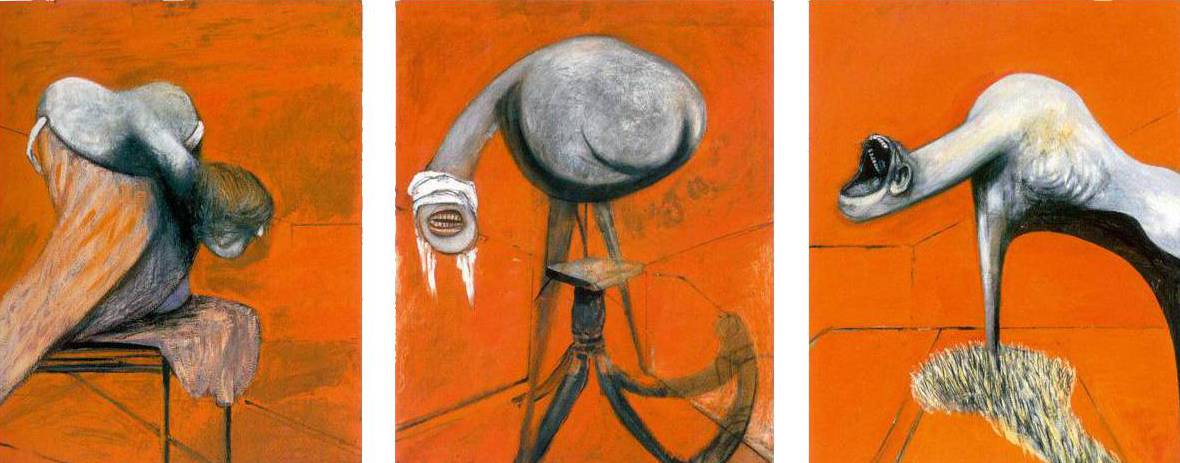
FRANCIS BACON (1909-1992)
'Three Studies for Figures at the Base of a Crucifixion', 1944 (oil on board)
The year 1944 was a turning point for Francis Bacon. He had destroyed most of the work he had produced to date as he believed that it failed to communicate the way he felt about the world. He wanted to make images that captured his visceral response on encountering a subject without any dependence on the traditional approaches to representation. As a declaration of faith in his own gut reaction he painted the triptych, ‘Three Studies for Figures at the Base of a Crucifixion’. Nobody had ever seen anything like it. The painting was designed to shock and jolted the senses of anyone who saw it. You either responded in awe at its intensity or in alarm at its severity. There was no middle ground with this work as it was impossible to ignore. Generally speaking, it met with widespread disapproval for its horrific imagery, but it became a milestone in British art and put Bacon on the map.
The 'Three Studies', bestial mutations of the human form, were Bacon's interpretation of the Aeschylean Furies: the three goddesses of vengeance (Alecto, Megaera, and Tisiphone) from Greek mythology. Their purpose was to punish crimes that were beyond human justice. Bacon painted the work at the end of World War Two as the accounts of the Nazi death camps were beginning to emerge and the three deformed figures were an apt metaphor for the corruption of the human spirit and the artist’s despair at man's inhumanity.
The Triptych Format
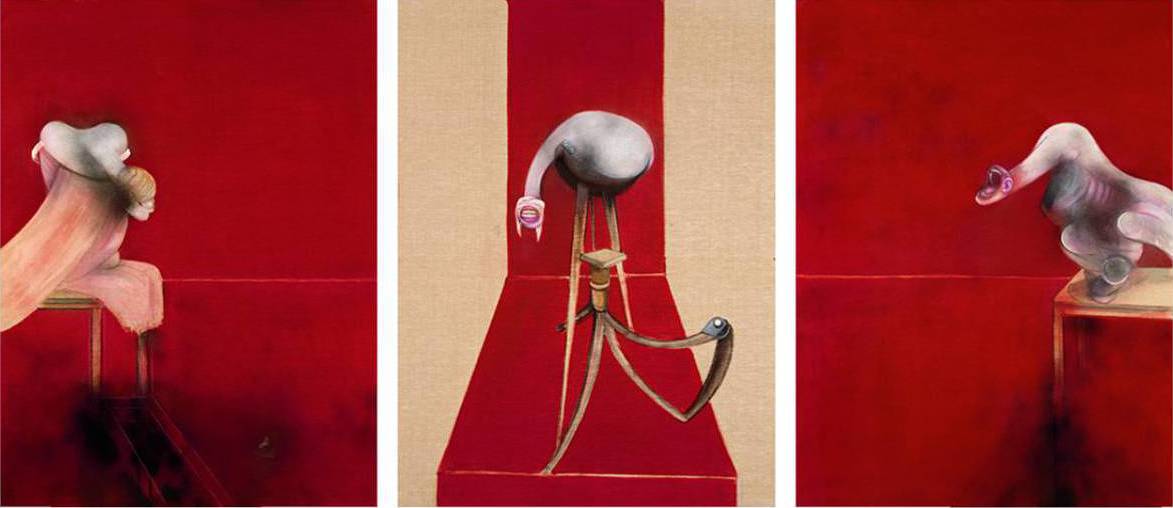
FRANCIS BACON (1909-1992)
'Second Version of Triptych 1944', 1988 (oil and aerosol paint on canvas)
'I see images in series. And I suppose I could go on long beyond the triptych and do five or six together, but I find the triptych is a more balanced unit'.
The ‘Three Studies for Figures at the Base of a Crucifixion’ was the first of many triptychs painted by Bacon. The triptych was a devotional format composed of three separate panels that was first used in Christian altarpieces. Bacon adapted this form of display for two reasons. First, exhibiting such godforsaken subjects in a religious format could only be viewed as a calculated act of desecration that would amplify their shock value and emotive response. Secondly, the adjacent frames of a triptych arrangement allowed Bacon to conduct an abstract or psychological narrative between the consecutive images. The idea to use a triptych format was probably inspired by the expressionist paintings of Max Beckmann which Bacon would have seen during his time in Berlin.
'Painting' 1946

FRANCIS BACON (1909-1992)
'Painting 1946' (oil on canvas)
Images of disquiet and distress are themes that continued in Bacon's paintings from 'Three Studies' onwards.
'Painting 1946' turns to the slaughterhouse for its iconography of anguish. Bacon sets the scene in a flesh colored room where any daylight has been blocked out by blinds. It is probably inspired by one of the many casino rooms he frequented, which shut out daylight and removed the clocks to alter their patron’s awareness of time. Cow carcasses are suspended from a ceiling bedecked with floral garlands to form an obscene crucifixion that hangs like a Renaissance backdrop to this malevolent spectacle. A threatening figure, formally dressed in a dark suit with a yellow buttonhole, sits beneath an umbrella that shades the upper half of his face, with only his menacing teeth and a bristling red moustache visible. He is encircled by a metal rail skewered with cuts of beef that drip blood red into the ornate carpet pattern. A bank of microphones sit on either side awaiting some alarming announcement. The atmosphere is laden with fear and forboding.
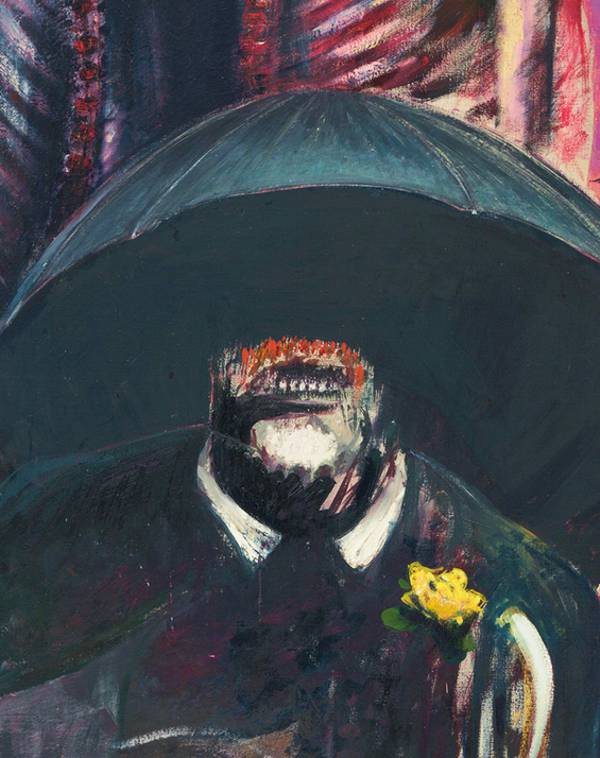
FRANCIS BACON (1909-1992)
Detail of 'Painting 1946' (oil on canvas)
When you look at paintings by Bacon there are two obvious questions that spring to mind:
-
Where does his imagery come from?
-
Why does he engage with such grim subject matter?
In relation to his choice of imagery Bacon said that “chance and what I call accident take over.” He was a compulsive gambler and risk taking was an inherent part of his personality, a trait that persists in his art. His search for an idea starts with some exploratory painting without any preparatory drawing. Then, through a process of editing and erasing, he discovers an 'accidental' form that holds his interest.
In ‘Painting 1946’, he claimed that he had no intention of creating its macabre figure. He began by painting a gorilla in a cornfield which was then overpainted with a bird of prey. After scraping both these ideas off the canvas, he saw that what remained suggested the mysterious form of a man beneath an umbrella. This strange figure, like most of Bacon's imagery, is partly detailed and partially unresolved, reading as both explicit and enigmatic.
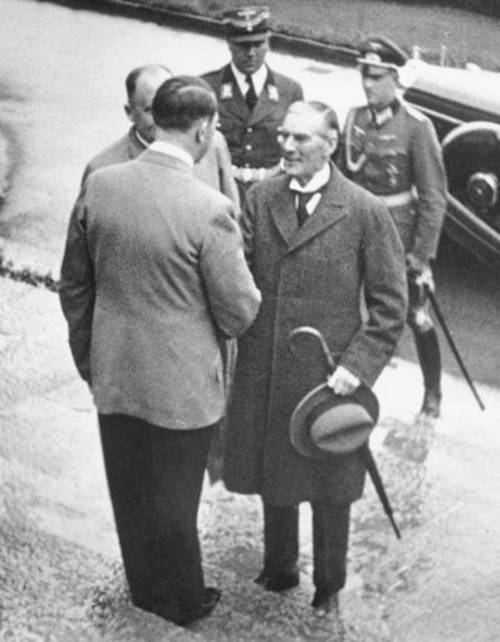
Hitler meets Chamberlain in 1938.
However, within a historical context, the attire of his figure takes on a significance that would be recognised by most people at that time. In 1938, Neville Chamberlain, the dark-suited British Prime Minister who never left home without his umbrella, returned from negotiations with Hitler naïvely waving the 'Anglo-German Peace Declaration' and announcing "peace for our time". The agreement was not worth the paper it was written on as Hitler violated the treaty and war was declared within a year. Bacon uses the relationship between the man and his umbrella, like the symbolic attributes of saints in Medieval art, [1] to recall the anxious prelude to war and the terrors that entailed. He takes further advantage of this 'accidental' metaphor to amplify the sense of threat by using an open umbrella indoors - a traditional omen of bad luck.
'Head 1' 1948
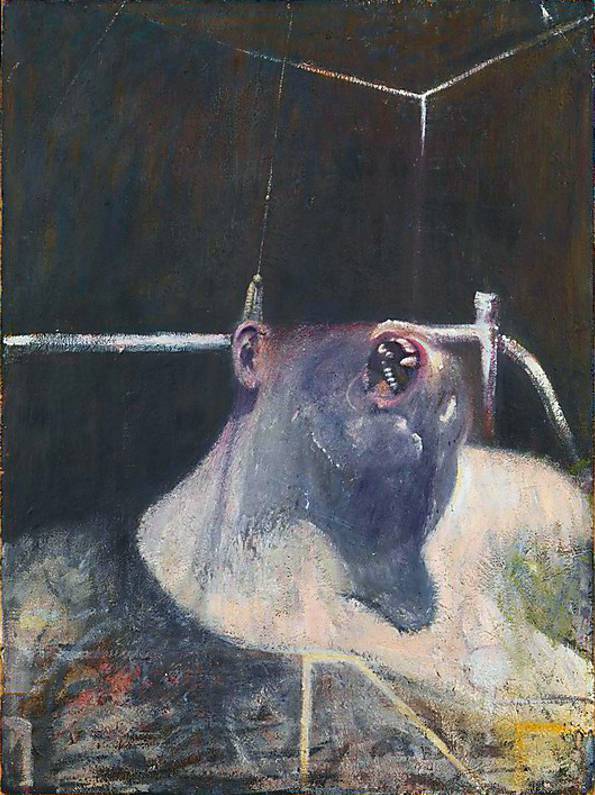
FRANCIS BACON (1909-1992)
'Head 1' 1948 (oil and tempera on hardboard)
In regard to his dark subject matter Bacon stated that "when you paint anything, you are not only painting the subject but you are painting yourself as well." By this he means it is not the conscious self that he paints but the unconscious. Through addressing his shadow self and projecting it into his art, his painting becomes a kind of therapy. However, his imagery is not an overt disclosure of his personal demons, more a manifestation of their visceral nature.
Bacon's immediate post-war paintings such as 'Head 1' (1948), a tortured animal/human hybrid, provoke a full gamut of emotions from fear to pain to shame to rage but they also induce a sense of compassion for their inescapable torment. He paints his subjects from a position of moral detachment, trapped in the hopeless isolation of their own private nightmare as they stare 'through a glass darkly' [2] to reflect the intimate anxieties of each observer.
Most of Bacon's paintings are mounted behind glass with heavy traditional frames. He uses the glass as a component part of the work to increase the level of tension by further alienating the subject, while at the same time pulling the viewer into the apparition through their reflection. His use of traditional frames was a device that associated his art with the dignity and substance of the old masters, an aspiration that would lead to his famous series of studies after Velazquez's portrait of Pope Innocent X.
Study after Velazquez's Portrait of Pope Innocent X

FRANCIS BACON (1909-1992)
'Study after Velazquez's Portrait of Pope Innocent X' 1953 (oil on canvas)
In 1953, Bacon painted ‘Study after Velazquez's Portrait of Pope Innocent X’. This painting, commonly referred to as 'The Screaming Pope', is considered to be his masterpiece. It is an existentialist assault on the Catholic Church, the social and religious establishment of his Irish childhood.
Velazquez's 'Portrait of Pope Innocent X' (1650) is a very perceptive work as it conveys the power of the pope, an astute political figure who was also a trained lawyer, while subtly revealing the suspicions and doubts of the inner man. Bacon was fascinated by this image and between 1951 and 1965 he painted around forty-five variations of the subject.
There is, however, nothing subtle about Bacon's version. His pope inhabits an ethereal world of perpetual torment – an emotional hell from which there is no escape. He is paralysed with fear and jolted by painful shocks from his golden throne, which has been transformed from a symbol of authority into an instrument of torture. The image seems to sit between dimensions as its form dissolves in a field of energy. The composition reaches a focal point in the primal scream that shrieks from the pope's gaping mouth - a scream that echoes from the past: ‘The Scream’ of Edvard Munch at the end of the 19th century which gave birth to modern Expressionist art.
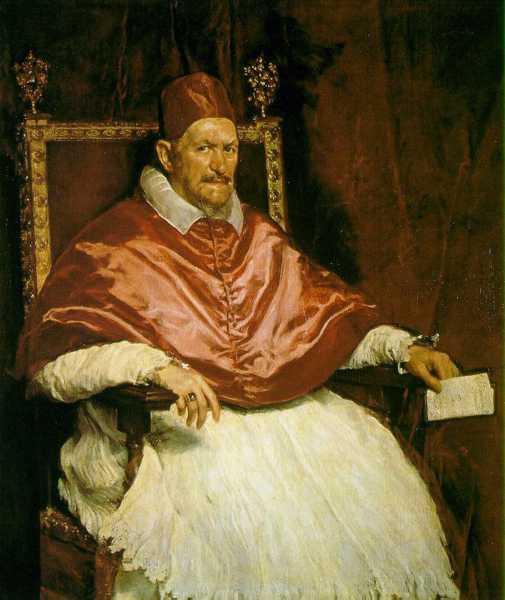
DIEGO VELÁZQUEZ (1599-1660)
'Portrait of Innocent X', c.1650 (oil on canvas)
The idea of producing variations on a work from the past was probably inspired by Picasso who reinterpreted works by Grünewald, Delacroix, Manet, Gauguin and Velazquez himself. Bacon said, ‘Picasso is the reason why I paint. He is the father figure, who gave me the wish to paint………. Picasso was the first person to produce figurative paintings which overturned the rules of appearance; he suggested appearance without using the usual codes, without respecting the representational truth of form, but using a breath of irrationality instead, to make representation stronger and more direct; so that form could pass directly from the eye to the stomach without going through the brain.’
Although Bacon had visited Rome, he claimed that he never saw Velazquez's original painting which hangs in the Villa Doria Pamphili and that he only worked from reproductions. He felt that a more intimate knowledge of the work would block his reactions and dominate his creative response to the image.
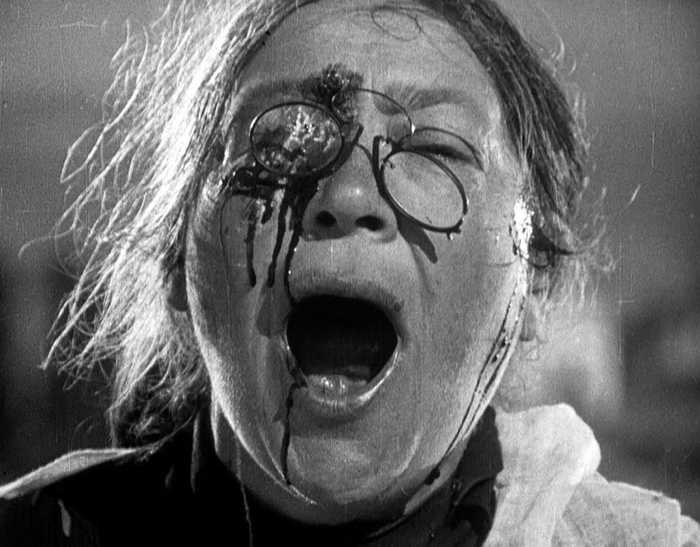
SERGEI EISENSTEIN (1898-1948)
‘The Battleship Potemkin’, 1925 (still photograph from the film)
Bacon also drew on other photographic sources to conjure up the final image of this work. The inspiration for the head of Innocent X comes from a still photograph from ‘The Battleship Potemkin’ (1925), a silent black and white film by Sergei Eisenstein. The image depicts the panic of a wounded nurse whose smashed pince-nez spectacles are splayed across her blood stained face. This fearful image held a fascination for Bacon who always kept a copy of it in his studio. It encapsulates his philosophy, ‘Painting is the pattern of one's own nervous system being projected on canvas’.
Titian’s portrait of Filippo Archinto (1558), where the cardinal archbishop of Milan is partially obscured by a transparent curtain, was probably the inspiration for the ghostly veil of paint that screens Bacon’s Pope.
Photographic Sources
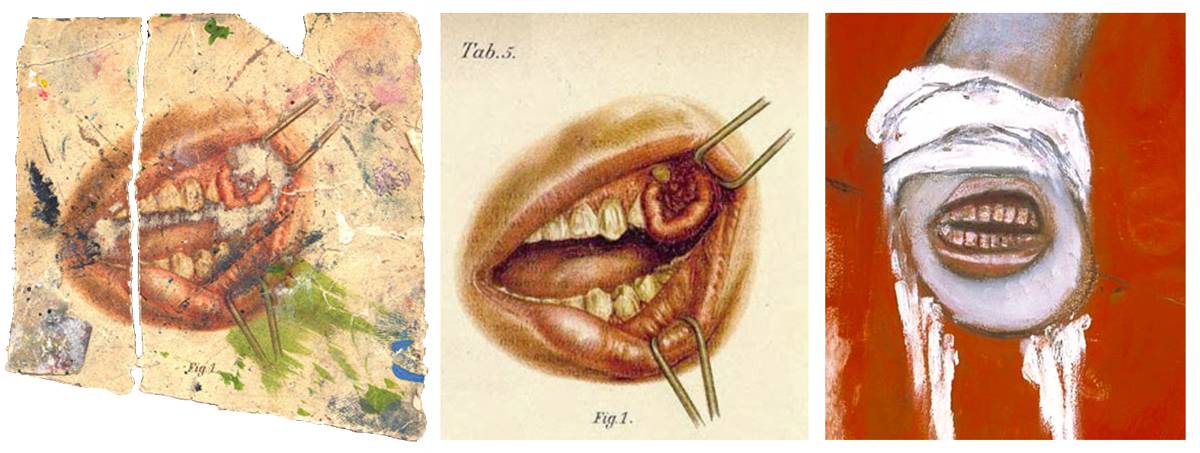
FRANCIS BACON (1909-1992)
'Source image for 'Three Studies for Figures at the Base of a Crucifixion', 1944.
Torn page from 'Atlas-Manuel Des Maladies De La Bouche Du Pharynx' 1903 by Ludwig Grünwald.
Francis Bacon never drew from life and always worked from photographs, probably due to his lack of traditional training. He was fascinated by the distressing imagery of disease and deformity found in medical books and collected these to use as provocative source material. The image above of an abscessed mouth, torn from an antiquarian book that he purchased while living in Paris, was found on the floor of his studio and is undoubtably the source of the Fury's mouth in 'Three Studies for Figures at the Base of a Crucifixion'. Another book of medical images that the artist referred to for some of his more tortuous poses was Clark's 'Positioning in Radiography' (1939), where figures are stretched and twisted to accommodate scanning. The rib cages and spinal columns that shine through x-ray photographs resurface as the butchered carcasses in his paintings. He also owned a copy of Eadweard Muybridge’s pioneering book from the 1880’s, ‘The Human Figure in Motion’ which explored movement through series of still sequential images of people walking, running, jumping, and wrestling. Muybridge’s photographs can be recognized as the source for many of the figures that appear in his work.
Although his paintings may start with the support of a secondary source, the development of its final form reveals the hand of a master. On viewing a major exhibition of Bacon's work, the spectator generally leaves the gallery, not with the anticipated shock and awe of its subject matter, but with a surprising sense of pleasure at his sensitive handling of paint.
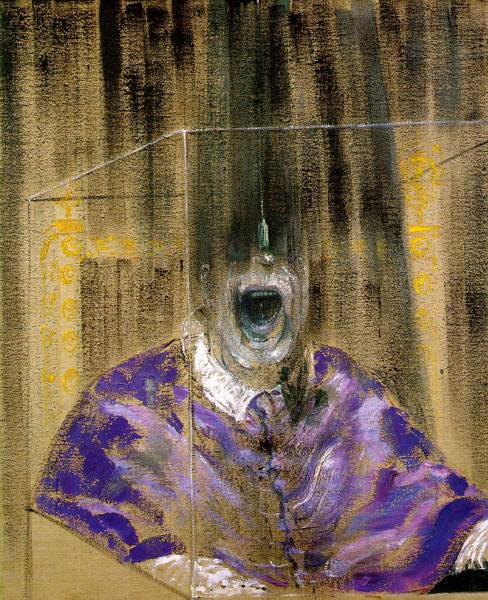
FRANCIS BACON (1909-1992)
'Head IV', 1949 (oil on canvas)
Francis Bacon's art abounds with paradox. He both repulses and seduces his audience simultaneously: he repulses them with his desolate subjects and dispassionate gaze, but he also seduces them with the sensual qualities of his paint.
The same kind of contradiction confounds his subject matter. While ‘Study after Velazquez's Portrait of Pope Innocent X’ attacks the authority of the Catholic Church it is also part of an obsessive fascination with its iconography - his crucifixion metaphors, the consistent use of the triptych format, and 45 variations on the 'Innocent X' theme is certainly obsessive. Like many artists, Bacon hides himself in such ambiguities and courts his enigmatic persona. In theory, he is a modern artist but there are so many indicators that his heart yearned for the company of the old masters and he does not look out of place in their midst. 'The job of the artist is always to deepen the mystery.........If you can talk about it, why paint it?'
Francis Bacon Timeline
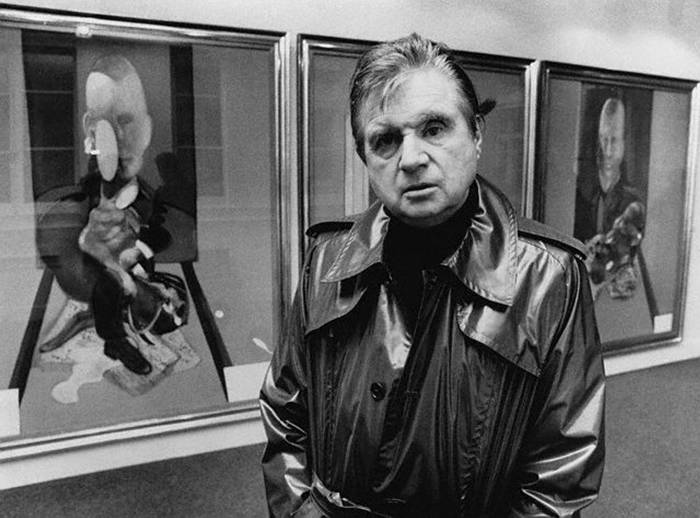
FRANCIS BACON (1909-1992)
The artist in front of 'Triptych' 1976, at an exhibition of his work at Claude Bernard Gallery, Paris,1977
Francis Bacon died, aged 63, on April 28, 1992. He was a unique artist without affiliation to any movement or style who spent a lifetime wrestling with his demons in the theatre of art with us as the astonished audience. The year after his death his biographer John Russell wrote, "There was painting in England before the 'Three Studies', and painting after them, and no one…can confuse the two."
-
1909 - Francis Bacon was born in Dublin, the second of five children. He endured a 'cold and hard' childhood at the hands of his authoritarian father and apathetic mother.
-
1927 - Moved to Berlin where he first saw Sergei Eisenstein's Battleship Potemkin, a major influence on his art.
-
1928 - Moves to Paris where he sees an exhibition by Picasso that inspires him to become an artist.
-
1929 - Returns to London and sets up an interior design studio while continuing to search for his artistic voice.
-
1933 - Paints 'Crucifixion', his first work to receive critical acclaim.
-
1937 - Contributes four works to the group exhibition 'Young British Painter' which included Graham Sutherland.
-
1944 - Paints 'Three Studies for Figures at the Base of a Crucifixion', his first major work that puts him on the artistic map.
-
1946 - 'Painting (1946)' exhibited at Musée National d'Art Moderne in Paris.
-
1948 - 'Painting (1946)' purchased by the Museum of Modern Art in New York.
-
1949 - Paints and exhibits 'Head IV' at the Hanover Gallery, London. This was the first of his series of paintings based on Velazquez 'Pope Innocent X'.
-
1952 - Represents Britain at the Venice Biennale
-
1953 - Paints his most famous version of the series, ‘Study after Velazquez's Portrait of Pope Innocent X’.
-
1958 - Represented by Marlborough Fine Arts who became his sole dealer until he died.
-
1960s - Starts to paint portraits of his friends and associates from the Colony Room, a private drinking club of which he was a lifelong member.
-
1962 - First major retrospective at the Tate Gallery.
-
1963 - Paints 'Three Studies for a Portrait of George Dyer'
-
1966 - Paints 'Portrait of Isabel Rawsthorne', friend and artist.
-
1969 - Paints 'Study of Henrietta Moraes' based on photos by John Deakin.
-
1969 - Paints 'Three Studies of Lucian Freud' which was sold in 2013 for US$142.4 million to American billionaire, Elaine Wynn.
-
1971 - His lover, George Dyer, commits suicide the night before his retrospective at the Grand Palais, Paris
-
1972-73 - Paints the Black Triptychs, an attempt to exorcise his grief over Dyer's death.
-
1976 - Paints 'Triptych 1976' which was sold in 2008 for US$86 million to Roman Abramovich, the Russian oligarch.
-
1985 - Second major retrospective at the Tate Gallery.
-
1992 - Died of heart attack while on holiday in Madrid.

